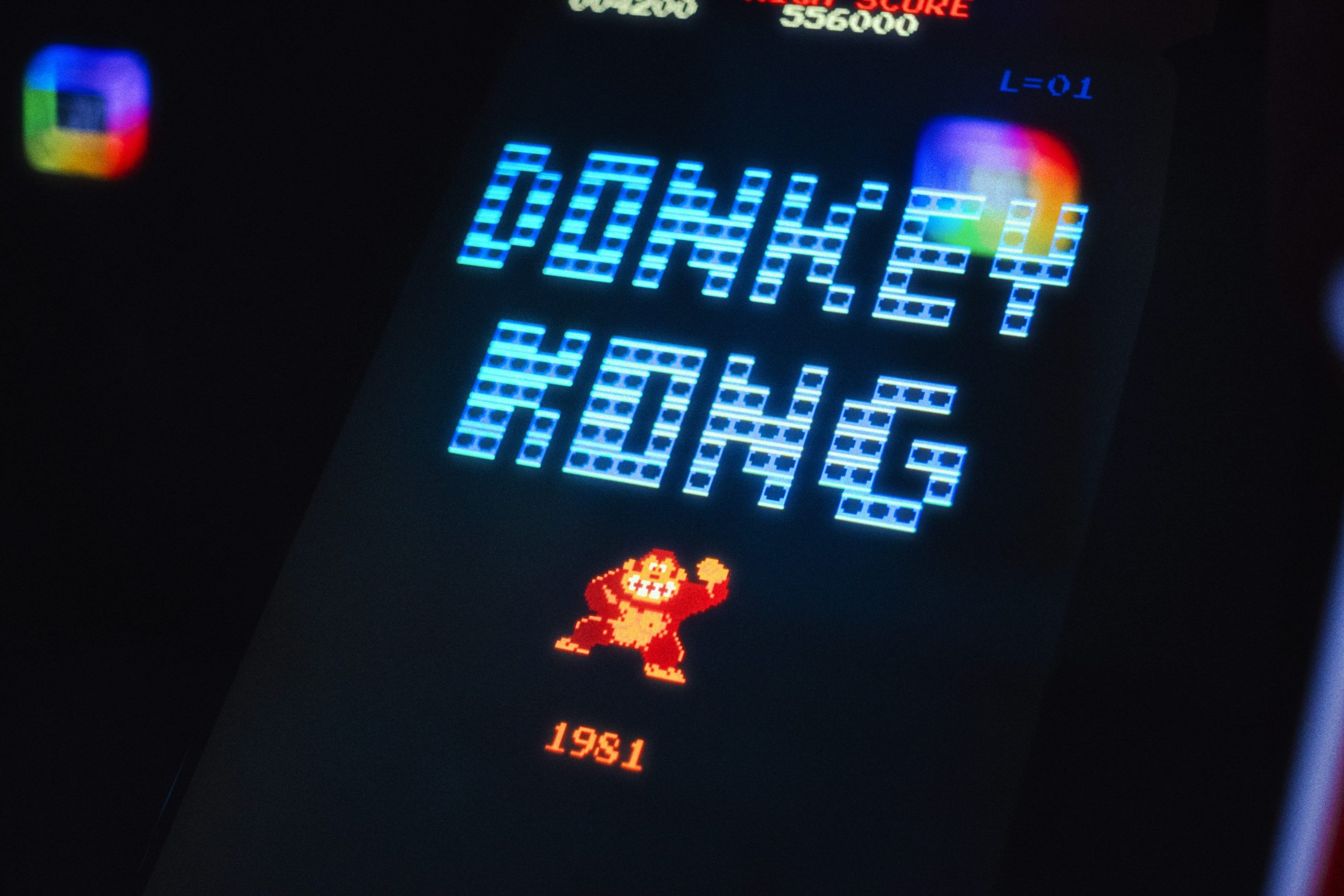Picture this: you’re standing in a neon-lit arcade circa 1981, quarters jingling in your pocket. You lock eyes with a towering cabinet, its bold Donkey Kong logo daring you to play. That first tumble of barrels is pure adrenaline.
In this donkey kong arcade game review we’ll dive into the origins, gameplay, graphics, and cultural impact of one of the most iconic arcade classics. You’ll discover why this platformer grabbed the world’s attention and still resonates with gamers today.
Explore game origins
The arcade crisis
Nintendo of America’s previous arcade title, Radar Scope, bombed in 1980. Thousands of unsold cabinets sat idle in a warehouse, draining resources. Executives faced a make-or-break moment: scrap the hardware or reinvent it. Something bold was needed to recoup losses and keep the company afloat.
Donkey Kong’s origins
Shigeru Miyamoto saw those unused machines as a creative opportunity. He pitched a comic-inspired story where a giant ape holds Pauline hostage and a plucky jumper named Jumpman comes to the rescue. Miyamoto picked “Donkey” to imply stubbornness and borrowed “Kong” from classic movie monsters. Jumpman eventually became Mario, named after the landlord who housed Nintendo’s storage facility.
Release and reception
When Donkey Kong hit arcades in July 1981, it sold out its initial run almost overnight. By summer 1982 the game had generated more than $280 million in US revenue, making it the top-grossing arcade title for two straight years. Critics praised its novel storytelling and tight controls, and players lined up for quarters. Who would have thought that this little ape-packed challenge would reshape gaming history?
Examine gameplay mechanics
Levels and obstacles
Donkey Kong serves up four distinct stages that test your reflexes and timing. On screen 1 you climb girders while leaping over rolling barrels. Screen 2 challenges you to navigate conveyor belts and dodge popping rivets in cement pans. In screen 3 you hop between elevators and springboards to clear gaps. Finally, in an epic boss fight you rescue Pauline while avoiding fireballs and falling girders. Ever wonder how players felt when they hit the infamous level 22 kill screen? Hardcore fans discovered a January 2025 glitch that lets you push past that limit and reach screen 135.
Controls and challenges
You move left and right and press a single button to jump—no fancy combos or midair direction changes. The simplicity makes every leap count, so missed timing means losing a life and starting over. You earn points by clearing obstacles, grabbing hammer power-ups, and smashing barrels. That hammer gives you a brief offensive boost and bonus points for extra thrills. Feeling the adrenaline with each perfectly timed jump shows why Donkey Kong remains a masterclass in arcade precision.
Assess graphics and sound
Visual style
Despite hardware limits, Donkey Kong’s pixel art feels surprisingly detailed. Colorful sprites stand out against dark backgrounds, making characters instantly recognizable in noisy arcades. Jumpman’s little red hat and overalls pop, while Donkey Kong’s chest-beating animation adds personality. Developers squeezed the most out of limited chips by animating each barrel roll and ladder climb with smooth movements. It’s like packing a blockbuster storyline into a postage-stamp screen—every pixel counts.
Iconic soundtrack
Instead of a full digital score, Donkey Kong uses catchy beeps and boops to set the mood. That simple melody when the game starts or when you grab a hammer became instantly memorable. In the absence of fancy audio hardware, composers played with tone and rhythm to craft earworms. You’ll find yourself humming these tunes long after you leave the arcade. Who knew a handful of beeps could stick in your head for decades?
Highlight cultural impact
Arcade popularity
At the height of its success, Donkey Kong cabinets earned up to $30 per day in US arcades, translating to about 120 plays weekly. Lines would form around corners as players traded tips on barrel-jump timing and ladder-climb tactics. It wasn’t uncommon to see a teenager beat six boards on a single quarter. Donkey Kong defined what an arcade hit should look like—a perfect blend of challenge and fun.
Universal lawsuit
Success also brought scrutiny. Universal Studios sued Nintendo in 1982, claiming Donkey Kong infringed on King Kong trademarks. After two years of legal wrangling, Judge Robert W. Sweet ruled in Nintendo’s favor, declaring “Kong” generic enough to be fair game. Nintendo even named its Kirby character after lawyer John Kirby and gifted him a sailboat in thanks. Who knew a courtroom battle could be as epic as the arcade itself?
Compare to modern experience
Home ports and emulation
By 1983 Donkey Kong had hopped onto the NES, Atari 2600, ColecoVision, and Game & Watch. While each version has its quirks—some lost a screen, others swapped audio cues—the core challenge remained intact. Today emulators let you play the arcade ROM on your phone or PC, complete with save states and rewind features. Still, no joypad quite matches the feel of that original four-way joystick and chunky jump button.
Modern re-releases
Nintendo has included Donkey Kong in multiple Classic Game Collections, like the Arcade Archives series and Switch Online Expansion Pack. These versions offer rewind options, online leaderboards, and screen filters that mimic CRT scanlines. Even so, you might crank the difficulty back to “normal” just to recapture that genuine quarter-eating tension. Isn’t it wild how you can now play arcade classics on your phone without dropping a single coin?
Reflect on legacy
Influence on platformers
Donkey Kong is widely credited as the first true platformer, kicking off a genre that would grow into Super Mario Bros, Sonic, and beyond. The simple act of jumping across obstacles felt revolutionary in 1981. Developers took cues from its level design and enemy patterns, building on the idea of narrative-driven gameplay. Without that little ape and his damsel-in-distress plot, our favorite jumps and power-ups might look very different today.
Series evolution
The franchise didn’t stop in arcades. Rare’s Donkey Kong Country reboot for SNES sold 9.3 million copies in 1994, proving DK’s star power on home consoles. Donkey Kong 64 followed in 1999 with 3D exploration and collectible hunts, blending Country’s visuals with adventure gameplay. In July 2025 Donkey Kong Bananza broke a 25-year 3D dry spell, becoming a killer app for Nintendo Switch 2. Can you imagine modern platformers without that pioneering barrel-jump session?
Platform evolution
| Title | Platform | Year | Notes |
|---|---|---|---|
| Donkey Kong | Arcade | 1981 | Saved Nintendo from financial crisis |
| Donkey Kong Country | SNES | 1994 | Third best-selling SNES game, 9.3 M sold |
| Donkey Kong 64 | N64 | 1999 | Brought DK to 3D with adventure focus |
| Donkey Kong Bananza | Switch 2 | 2025 | Critical comeback as a 3D platformer |
Review key takeaways
- Donkey Kong turned unsold Radar Scope cabinets into a multi-million dollar success that saved Nintendo’s US branch
- Four distinct screens and precise jump controls defined arcade platforming for generations
- Minimalist graphics and catchy beeps crafted an unforgettable visual and audio signature
- Winning a landmark lawsuit against Universal Studios affirmed video game originality as legal art
- The series blossomed through Rare’s Country reboot, 3D adventures, and modern re-releases that still resonate today
Whether you’re chasing high scores on the original cabinet or reliving memories on Switch Online, Donkey Kong’s timeless design continues to deliver thrills. Got a favorite barrel-jump moment or quarter-crunching tale? Share your memories in the comments below so the Golden Age never fades.



Leave a Reply